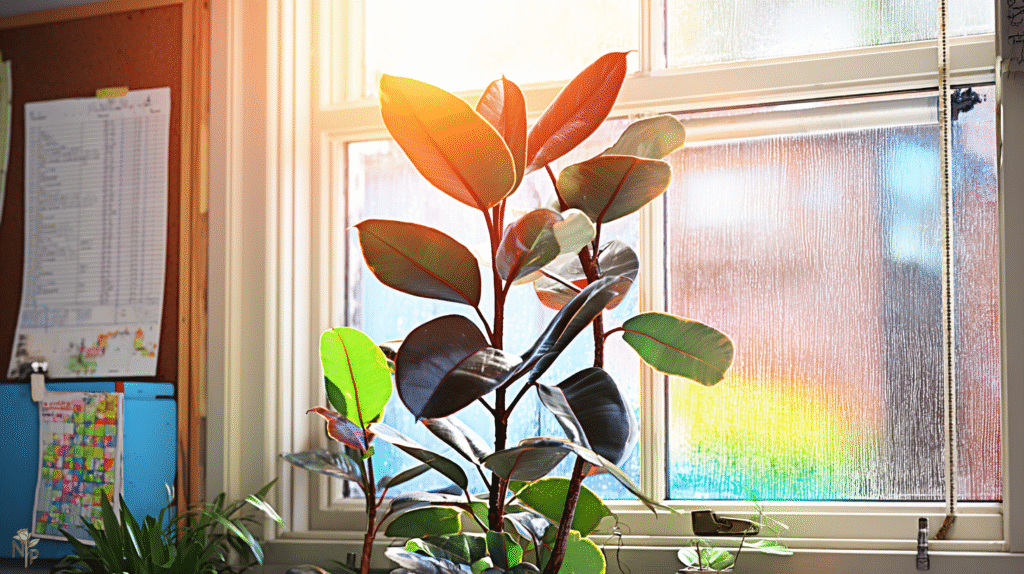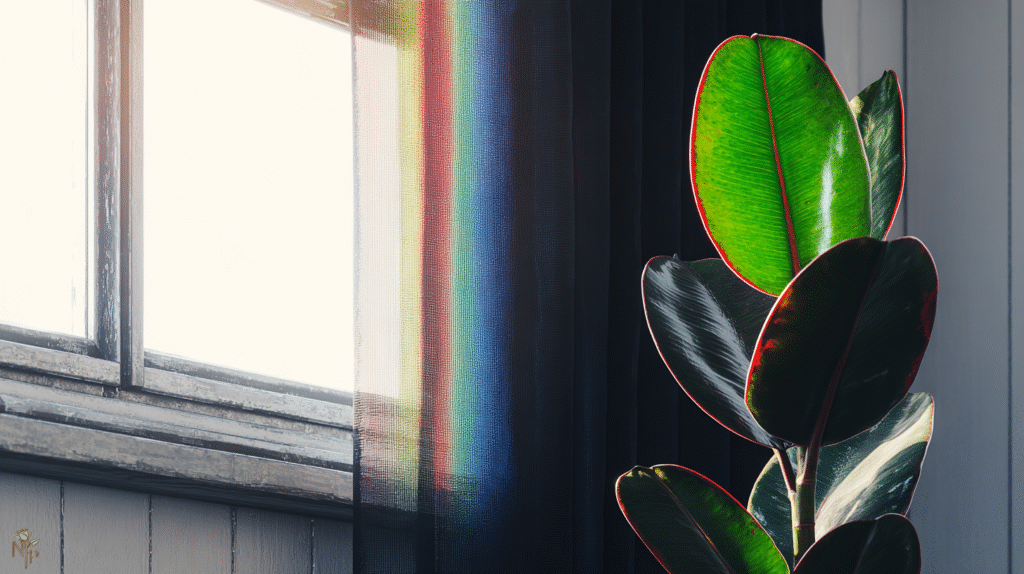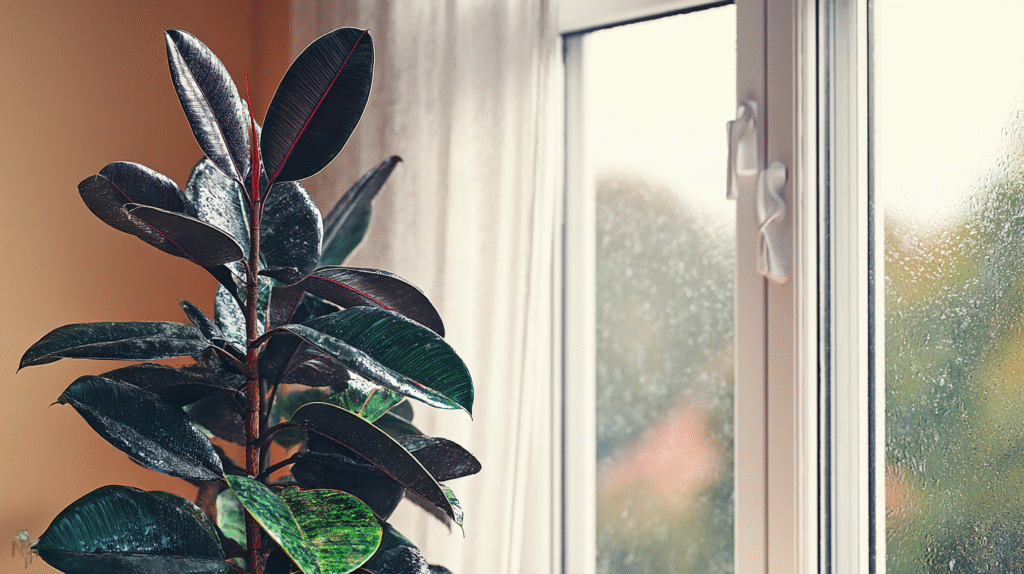My first rubber plant lived in what I called “bright indirect light” — translation: a dark corner six feet from a north window. For three months, I watched it slowly give up on life. Leaves dropping one by one. New growth coming in pale and tiny. The whole plant leaning toward the window like it was trying to escape.
“But the care tag said low light!” I complained to anyone who’d listen.
Turns out, plant care tags lie. Or at least they stretch the truth. “Tolerates low light” doesn’t mean “thrives in your cave-like apartment.” My rubber plant was technically alive in that corner, the same way I’m technically exercising when I walk to the fridge. Surviving, not thriving.
Fast forward two years, and I have four rubber plants that look like they’re on plant steroids. Glossy leaves bigger than my hand. New growth popping out constantly. The secret? Finally understanding what rubber plants actually mean when they say they want light.

The Great Light Lie We’ve All Believed
Here’s what nobody tells you: rubber plants (Ficus elastica) are trees. TREES. In their natural habitat, they grow up to 100 feet tall in bright tropical forests. Then we stick them in our apartments and wonder why they’re not thrilled about that corner behind the couch.
The confusion comes from two things:
- They won’t immediately die in low light (making them seem “tolerant”)
- Plant sellers know “low light” sells better than “needs your brightest window”
My rubber plant in that dark corner? It survived for six months. But it looked like plant depression — sparse leaves, no growth, generally sad existence. The one I moved to bright light? Doubled in size in the same timeframe.
What “Bright Indirect Light” Actually Means
This phrase made me crazy for years. Every plant wants it, nobody defines it. Here’s what it means for rubber plants specifically:
The hand shadow test: Put your hand between the plant and the light source during peak daylight. You want to see a fuzzy, soft shadow — not sharp and dark (too bright) or barely visible (too dim).
The reading test: Can you comfortably read a book where your plant sits without turning on a lamp during the day? If yes, that’s probably bright enough.
Distance from windows:
- South window: 2-5 feet back or with sheer curtains
- East window: Right up against it or 1-2 feet back
- West window: 2-3 feet back (afternoon sun is intense)
- North window: Directly in it, and it’s still borderline
My thriving rubber plant sits 3 feet from a south window with sheer curtains. It gets about 4-5 hours of filtered sun daily. The difference from its dark corner days? Night and day. Literally.
How Light Affects Rubber Plant Growth
Light doesn’t just keep your rubber plant alive — it determines everything about how it grows:
In proper bright light:
- Leaves grow large and thick
- Deep green color (or vibrant variegation)
- Compact growth between leaves
- New leaves monthly during growing season
- Strong stems that support themselves
In too little light:
- Small, pale leaves
- Massive spaces between leaves (etiolation)
- Slow or no growth
- Lower leaves drop off
- Whole plant leans desperately toward light
In too much direct sun:
- Bleached or brown patches on leaves
- Crispy edges
- Leaves curl to protect themselves
- Variegated types lose color
I learned the hard way when I moved my rubber plant from dark corner to full sun immediately. Sunburn city. Now I transition gradually over 2-3 weeks.
Different Varieties, Different Needs
Not all rubber plants are light equals. My collection taught me this:
Regular green (Ficus elastica): Most forgiving. Happy with medium to bright light. My starter plant that survived the dark corner.
Burgundy/Black Prince: Needs MORE light to maintain that deep color. In lower light, it reverts to boring green. Mine sits in my brightest spot.
Variegated (Tineke, Ruby): Light hogs. That cream and pink variegation? Disappears fast without bright light. My Tineke gets more light than any other plant I own.
Petite varieties: Slightly more tolerant of medium light, but still prefer bright. Good for smaller bright spaces.
The rule: The more variegation, the more light needed. That stunning tri-color Ruby? It’s basically a solar panel disguised as a plant.

Seasonal Light Changes Nobody Mentions
Your perfect spot in summer might be a death trap in winter. I learned this when my happy rubber plant started dropping leaves every November. Turns out, winter light is dramatically weaker.
Summer adjustments:
- Move plants back from windows
- Use sheer curtains
- Watch for sunburn as sun angle changes
- Growth explodes (feed regularly)
Winter reality:
- Move closer to windows
- Remove filtering curtains
- Clean windows (seriously, it helps)
- Accept slower growth
- Maybe add grow lights
I supplement with a basic LED grow light in winter. Nothing fancy — just a $25 bulb in a regular lamp pointed at my plants for 6-8 hours. Game changer for maintaining growth year-round.
Signs Your Rubber Plant Is Light-Starved
After killing my first one slowly in low light, I know the signs:
The lean: Whole plant tilts toward light source. Mine was practically horizontal before I moved it.
The stretch: New leaves are far apart. Stem shows between leaves instead of tight growth.
Leaf drop: Older leaves yellow and fall. Plant can’t support them all with limited light.
Pale new growth: New leaves come in light green instead of rich, dark green.
No growth: In growing season but nothing happening? Probably needs more light.
Small leaves: New growth is tiny compared to older leaves.
My rubber plant showed ALL these signs. I kept fertilizing, adjusting water, repotting — everything except addressing the actual problem. Don’t be me.
Creating Ideal Light Conditions
Here’s my system that transformed sad rubber plants into showpieces:
Placement strategy:
- Start conservative (medium light)
- Gradually move closer to windows
- Watch for stress signs
- Find the sweet spot
Rotation routine:
- Quarter turn weekly
- Prevents lopsided growth
- Ensures even light exposure
- Mark pot with tape to track
Window treatments:
- Sheer curtains for south/west windows
- Nothing needed for north/east usually
- Adjustable blinds give flexibility
Artificial supplements:
- Basic grow bulbs work fine
- 12-16 inches from plant
- 8-12 hours daily in winter
- Timer makes life easier
Common Light Mistakes I Made
The instant move: Relocated from dark to bright overnight. Shocked the plant badly. Now I move gradually over weeks.
Forgetting to rotate: Created a lopsided monster. One side lush, other side sparse. Took months to correct.
Trusting “low light tolerant”: Wasted six months watching slow decline. Tolerant doesn’t mean happy.
Not adjusting seasonally: Wondered why winter growth stopped. Didn’t consider weaker winter sun.
Ignoring variety needs: Treated variegated like regular green. Lost most of the pretty colors.
My Current Lighting Setup
After all the failures, here’s what works:
Living room: Large green rubber plant 4 feet from south window. Gets 4-5 hours bright indirect light.
Office: Burgundy variety directly in east window. Morning sun gives deep color.
Bedroom: Tineke 2 feet from west window with sheers. Variegation is stunning.
Kitchen: Small Ruby under grow lights on counter. No good windows but thriving.
All get rotated weekly, moved slightly with seasons, and watched for stress signs. The difference from my “low light tolerant” days is incredible.

The Bottom Line on Rubber Plant Lighting
Stop believing the “low light” myth. Your rubber plant doesn’t want to live in a cave any more than you do. It wants bright, indirect light — real brightness, not “well, I can sort of see in here” brightness.
If your rubber plant is dropping leaves, growing slowly, or looking generally pathetic despite good care, it’s probably screaming for more light. Move it closer to a window. Add a grow light. Do something before it stages a full plant mutiny.
My former dark corner dweller? Now lives by my brightest window and has tripled in size. Same plant, same care routine, completely different light situation. The only thing I regret is waiting six months to figure out something so simple.
Light is literally plant food. Stop starving your rubber plant and watch it transform into the glossy-leaved showpiece it wants to be. Your future giant rubber tree will thank you. 🌱






